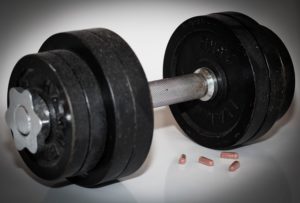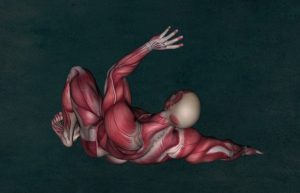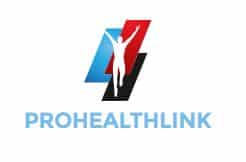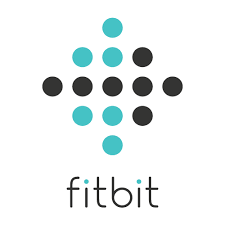The effects Of Exercise On Testosterone – According to a recent Gallup poll, approximately 15% of Americans engage in weight training three or more days per week (14). The improvement in muscular strength and hypertrophy gained from resistance training is due to acute and chronic elevations in circulating blood hormone concentrations (12). The endocrine (i.e., meaning hormone secreting) system is a system of glands that discharge hormones that regulate body functions. Understanding the function of the endocrine system and the hormonal changes during resistance training is meaningful for all exercise professionals. It also is relevant to recognize that the U.S. Department of Health and Human Services recommends all active adults complete at least one set of 8 to 12 repetitions of each exercise for the major muscles of the body and that two or three sets may be more effective (15). The acute hormonal responses to resistance exercise discussed in this article help to explain the muscular fitness responses observed in clients who weight train on a regular basis.

Table of Contents
HORMONES 101
The role of the endocrine system is to maintain the body’s homeostasis through the release of hormones into the circulatory system. Hormones are chemical messengers that allow the transmission of messages from one part of the body to another. Hormones are released in small concentrations and regulate physiological and metabolic function, such as protein synthesis. They affect the human body in several ways, including the regulation of growth, development, reproduction, and the body’s ability to handle physical and mental stress. Hormonal action can last from seconds to hours.
The ability for the target tissue to respond to a hormone depends on the presence of specific receptors in or on the tissue. Once bound, the hormone can influence cellular metabolism (i.e., reactions). Hormones are classified by their chemical structures as amines, peptides (proteins), and steroids (see Figure for more on hormones).
THE IMPORTANCE OF HORMONES DURING RESISTANCE TRAINING
Resistance exercise stimulates acute hormonal responses and subsequent physical adaptation (i.e., muscle growth). The appropriate resistance exercise prescription combined with manipulation of the acute program variables ensures an optimal hormonal response. Acute program variables, such as training frequency, exercise selection and sequence, intensity (% of one repetition maximum [1 RM]), volume (sets × repetitions), rest intervals, and repetition speed are important factors in the hormonal response to resistance exercise (12). In general, there seems to be a minimal threshold of intensity and volume (i.e., 50% to 60% 1 RM; less than three sets) to elicit the desired hormonal response. Program design that includes progressive overload, variation, and specificity will ensure adequate adaptations of the neuromuscular system by increasing motor unit recruitment and allowing greater hormone release.
Besides the exercise training stimulus, other uncontrollable factors, such as genetic predisposition, age, and sex, can play a role in the endocrine responses and adaptations to resistance training. Finally, controllable factors, such as fitness level, nutritional intake, training experience, interactions with other exercise modalities, and diurnal variations, can influence the acute and chronic hormonal responses to resistance exercise (12).

ACUTE HORMONE RESPONSE TO RESISTANCE EXERCISE
Most of the research regarding hormonal response to resistance exercise has focused on acute changes that occur during resistance training or immediately after exercise (usually 0 to 48 hours). This differs from chronic changes (i.e., long-term; weeks to months) in resting hormone concentrations and long-term changes in the acute hormonal response to a single bout of resistance exercise. The following is a review of the key hormones and their acute response to resistance exercise.

Catecholamines
The acute response to resistance training involves increases in concentrations of epinephrine, norepinephrine, and dopamine, referred to as catecholamines. Catecholamines are important for increasing muscle force production and improving energy availability. There also is evidence that catecholamines may improve the functions of other hormones such as testosterone and growth hormone (GH) (5,10). The increase in blood concentrations of catecholamines may be dependent on the amount of muscle mass stimulated, the volume of exercise performed, and the rest interval between sets (5,6,10).
An acute bout of resistance exercise training can increase plasma levels of both epinephrine and norepinephrine. Epinephrine increases both glycogenolysis (breakdown of glycogen) in the muscle and lipolysis (breakdown of fat) in adipose tissue (6). Physically demanding exercise increases caloric expenditure while stimulating a greater release of epinephrine and norepinephrine. Research has confirmed an increase fat mobilization during resistance training, which is stimulated through the release of epinephrine (5). Although evidence suggests that only a small portion of the total fatty acids may actually be oxidized, the increased lipolysis during resistance exercise may contribute to the success of training programs aimed at body fat reduction (6). For clients interested in losing body fat, resistance training programs using high volume (4 to 6 sets per exercise) and short rest between sets (<1 minute) can elicit a larger catecholamine response. Systematic variation and progressive overload may be critical in maintaining the acute training-induced elevations of epinephrine and norepinephrine (10,12).

Growth Hormone
Growth hormone is a protein-based peptide (an amino acid combined to a carboxyl molecule) hormone secreted from the anterior pituitary gland that exists in different forms (called isoforms) in the blood; they are important in the growth of all body systems. Resistance exercise has been shown to increase concentrations of GH up to 30 minutes after exercise in both men and women (3,12). The magnitude of the GH response seems to be dependent on exercise selection, intensity, volume, training status, and most importantly, rest intervals between sets. Multi-joint exercises that recruit a large amount of muscle mass using concentric (muscle shortening) muscle actions produce larger increases in GH compared with single-joint exercises focusing on eccentric (muscle lengthening) muscle actions. Total work during a resistance training session is important, with multiple-set protocols eliciting a greater GH response than single-set protocols. Resistance training protocols with high total work and short rest intervals between sets tend to produce substantial GH responses (16). Goto et al. (8) showed that a single high repetition set of knee extension exercise with 50% of 1 RM at the end of an entire strength training protocol (five sets of knee extension using 90% of 1 RM) elicits a significantly higher GH response compared with a traditional strength training workout without the high repetition set. Finally, greater acute elevation in the GH response is found in trained individuals who are stronger and able to perform a large volume of exercise (2).
Insulin-like Growth Factors
Insulin-like growth factors (IGFs) are small polypeptide (molecule made up of a string of amino acids) hormones secreted by the liver. IGFs are secreted in response to an increase in GH. IGFs increase protein synthesis and enhance muscle hypertrophy in response to resistance exercise. The most extensively studied IGF is IGF-1. The acute response of IGF-1 to resistance exercise remains elusive. Most studies have shown no change in IGF-1 during or immediately after resistance exercise, whereas a few other studies have shown acute elevations during or immediately after exercise (12). For a client wishing to gain maximal muscle mass, workouts consisting of large muscle groups, multiple sets, moderate intensity, and short rest periods between sets will produce the largest increases in IGF-1.

Cortisol
Cortisol is a steroid hormone that is released in response to an increase in adrenocorticotropic hormone (ACTH; corticotropin), a pituitary hormone that stimulates cortisol release from the adrenal cortex (of the adrenal gland, which is on top of the kidneys). Cortisol has catabolic effects on skeletal muscle, adipose tissue, and the liver. It stimulates lipolysis (breakdown of fat) in adipose cells and increases protein degradation and decreases protein synthesis in muscle cells.
Resistance exercise can cause acute elevations in ACTH and subsequently cortisol with the response being similar in both men and women. Training programs designed to increase muscle hypertrophy that include a high volume, moderate to high intensity, and short rest periods between sets significantly increase the cortisol response, whereas power/strength training programs with low volume, high intensity, and long rest periods between sets produce minimal change in the acute cortisol response (9). Excessive cortisol release may be a result of overtraining.
Testosterone
Testosterone is a steroid hormone that is primarily secreted by the testes in male subjects and the ovaries in female subjects. Smaller amounts of testosterone are secreted by the adrenal glands in both sexes, with adrenal secretion playing a significant role in resistance exercise-induced raises in some women. Testosterone produces both anabolic (tissue building) and androgenic (secondary sexual characteristics) effects in the body. Anabolic effects include increasing musculoskeletal mass and strength.
Resistance exercise produces an acute increase in total testosterone concentrations in men (3), whereas the results in young women have been equivocal, with some showing no change and other research showing elevations (9). Acute serum total testosterone responses after resistance training are influenced by several factors, including exercise selection, intensity and volume, training experience, caloric intake, and protein/carbohydrate supplementation (12,16). Exercises that use a large amount of muscle mass, such as the Olympic lifts (e.g., clean and jerk; snatch), squats, and dead lift, produce larger elevations when compared with single-joint exercises using a smaller muscle mass. High-volume, moderate-intensity training sessions with short rest intervals (i.e., 3 to 4 sets of 10 to 20 repetitions at 50% to 70% of 1 RM, 2-minute rest periods) have been shown to produce greater testosterone increases than traditional strength training protocols that use high-load, multi-set training sessions with long (3-minute) rest intervals between sets (9,10).

Estrogen
Estrogens are steroid hormones that are synthesized and secreted by the ovaries and adrenal glands in women. Men also produce estrogen through a conversion process known as aromatization. Estrogens perform various bodily functions including the slowing of bone and muscle loss during aging. Research has shown differences in the rate of muscle decrement during aging between men and women, and this difference may be due to changes in sex hormones (13). Whereas lower testosterone levels in men contribute to the decline in muscle strength, the relationship between estrogen levels in women to muscle strength loss is less understood.
Studies show an accelerated loss of muscle and strength immediately after menopause. Estrogen may play a protective role in muscle strength and quality through the actions of the estrogen receptor (ER). Dieli-Conwright et al. (7) found greater enhancements of ER activity after a single eccentric exercise bout in postmenopausal women using hormone replacement therapy, compared with controls. This suggests that estrogen plays an important role in the development of muscle after resistance exercise. Fitness professionals should recognize the varying roles estrogen plays in the female body and understand that muscle mass and strength gains may be influenced by menopause and/or if the client is taking estrogen replacement medication.
SUMMARY
Resistance exercise elicits an impressive response in various hormone concentrations of the body that are central for muscle growth and repair (Table). This acute hormonal response seems to be influenced by the exercise stimulus (i.e., intensity, volume, muscle mass involved, rest intervals, frequency). It is hoped, from this brief review of acute hormonal responses of resistance exercise, that exercise professionals will be able to better explain, describe, and communicate to their clients and students how the development of muscle strength and endurance occurs.
CONDENSED VERSION AND BOTTOM LINE
Hormones play a significant role in the body’s response to resistance exercise. Muscle mass, strength, and body composition are influenced by the hormonal responses after resistance exercise. Manipulating acute program variables, such as volume, intensity, rest between sets, exercise selection, the muscle mass involved, and workout duration, can impact acute hormonal responses associated with resistance exercise.
References
1. Aagaard P, Anderson JL. Effects of strength training on endurance capacity in top-level endurance athletes. Scand J Med Sci Sports. 2010;20(Suppl. 2):39–47.
2. Ahtianen JP, Pakarinen A, Alen M, et al. Muscle hypertrophy, hormonal adaptations and strength development during strength training in strength-trained and untrained men. Eur J Appl Physiol. 2003;89:555–63.
3. Ahtianen JP, Pakarinen A, Kraemer WJ, et al. Acute hormonal and neuromuscular responses and recovery to forced vs maximum repetitions multiple resistance exercises. Int J Sports Med. 2003;24:410–8.
4. Bell GJ, Syrotuik D, Martin TP, et al. Effect of concurrent strength and endurance training on skeletal muscle properties and hormone concentrations in humans. Eur J Appl Physiol. 2000;81:418–27.
5. Chatzinikolaou A, Fatouros I, Anatoli P. Adipose tissue lipolysis is upregulated in lean and obese men during acute resistance exercise. Diabetes Care. 2008;31:1397–9.
6. De Glisezinski I, Larruoy D, Bajzova M, et al. Epinephrine but not norepinephrine is a determinant of exercise-induced lipid mobilization in human subcutaneous adipose tissue. J Physiol Published online before print May 5, 2009, doi: 10.1113/jphysiol.2009.1689
7. Dieli-Conwright CM, Spektor TM, Rice JC, Sattler FR, Schroeder ER. Hormone replacement therapy and messenger RNA expression of estrogen receptor coregulators after exercise in postmenopausal women. Med Sci Sports Exerc. 2010;42(3):422–9.
8. Goto K, Sato K, Takamatsu K. A single set of low intensity resistance exercise immediately following high intensity resistance exercise stimulates growth hormone secretion in men. J Sports Med Phys Fitness. 2003;43:243–9.
9. Hakkinen K, Pakarinen A. Acute hormonal responses to heavy resistance exercise in men and women at different ages. Int J Sports Med. 1995;16:507–13
10. Kraemer WJ, Noble BJ, Clark MJ, et al. Physiologic responses to heavy-resistance exercise with very short rest periods. Int J Sports Med. 1987;8:247–52.
11. Kraemer WJ, Patton JF, Gordon SE, et al. Compatibility of high-intensity strength and endurance training on hormonal and skeletal muscle adaptations. J Appl Physiol. 1995;78:976–89.
12. Kraemer WJ, Ratamess NA. Hormonal responses and adaptations to resistance exercise and training. Sports Med. 2005;35(4):339–61.
13. Lowe DA, Balgalvis KA, Greising SM. Mechanisms behind estrogen’s beneficial effect on muscle strength in females. Sport Sci Rev. 2010;38(2):61–7.
14. Saad, L. Few Americans meet exercise targets. Gallup [Internet]. 2008. Available from: Gallop.com: http://www.gallup.com/poll/103492/few-americans-meet-exercise-targets.aspx#1. Accessed September 23, 2011.
15. U.S. Department of Health and Human Services. 2008 Physical Activity Guidelines for Americans [Internet]. ODPHP Publication No. U0036, October, 2008 [cited 2011 January 20]. Available from: http://www.health.gov/paguidelines/guidelines/chapter4.aspx.
16. Williams AG, Ismail AN, Sharma A, et al. Effects of resistance exercise volume and nutritional supplementation on anabolic and catabolic hormones. Eur J Appl Physiol. 2002;86:315–21.
https://journals.lww.com/acsm-healthfitness/Fulltext/2011/11000/AN_EXERCISE_PROFESSIONAL_S_GUIDE_TO_ACUTE_HORMONAL.7.aspx






